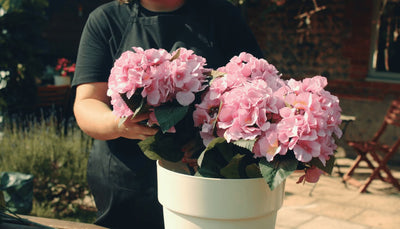
It’s beginning to look a lot like Christmas! Without a needle on the floor, our Christmas collection is here to bring instant, easy and unbelievably beautiful colour this festive season.

Its not uncommon for artificial flowers and plants to be scentless or have a slight, less-than-desirable, plasticky smell. Don't let this stop you from going faux! It's easy to level up your artificial flowers (and plants) by making them smell as good as they look.
Whether you want a strong scent or something more delicate, we have tried and tested several types of scent, and application methods, so you don’t have to!
Before we begin adding scents, it’s important to clean your artificial flowers regularly to stop the build-up of dust and mildew. The build-up of mildew could be causing your flowers to have a bad smell. For more information or advice on cleaning, check out our how to clean artificial flowers blog.
The short answer is yes, you can add scents to artificial flowers.
From essential oils to perfumes, there are many options for how you may choose to scent your fauxs. It is important to consider that different methods could alter the appearance of your flower or plant - i.e. using an essential oil on a 'waxy' leaf, may give the leaf a shiny, 'wet' appearance.
Popular methods used to scent faux flowers and plants are:
Perfume
Essential oil
Scented lotion / scented creams
We have tried and tested the different methods of scenting artificial flowers. To find out more about our in-house testing, the results and our recommendations, see 'our in-house testing' below.
It is important to consider what texture your fauxs are; 'waxy' artificial flowers and leaves may not hold scents the same as 'fabric' artificial flowers and leaves. To find out what methods we found worked best for both 'waxy' and fabric fauxs, read on.
Before you begin adding scents to your faux foliage, ensure you are in a well-ventilated space.
For sprayed scents, you can either hold the plant or faux stem at a distance and lightly spray the plant all over, or for a more realistic effect, you can use the spray close up and spray just the flowers.
One to two drops of essential oil or liquid diffuser scent can be added directly to the centre of a flower.
To add the scent to artificial leaves, add one to two drops of scent to a cloth and 'buff' into the leaf.
To prevent any colour distortion to your artificial stems, we advise opting for an alcohol free diffuser liquid.
For scented creams or lotions, simply add a pea-sized amount to your hand and 'massage' into the plant.
To enhance your artificial experience, try finding the matching scent of your faux. Applying a rose scent to a fabulous faux rose will easily make it mistakable for the real thing!
For flowers, gentle, floral scents will create the most realistic tone; as for foliage, a menthol or woody pine scent will work best.
Essential oils are often very strong and can be too overpowering. Try to find essential oils that best suit your type of faux, for example, using lemon grass essential oil on a grass plant could be effective as well as realistic.
We conducted an experiment to see which methods work best for scenting your artificial flowers and leaves.
To ensure the test was fair, each application method has one scent that was used across both products being tested on. The different scenting methods were tested on our cabbage rose stem, which features light, fabric-type petals, and our pothos leaf stem which has a hardier, 'waxy' texture.
Each method was given a strong, unique scent - so the scent that lasts the longest and is most effective could be easily identified.
The scents used:
Essential oil: tea tree
Diffuser liquid: echinacea & elderberry
Perfume: raspberry & orange blossom
Scented lotion: sweet lime & vanilla
Scented products were tested against an unscented product, products were tested immediately after scent was applied and In hourly intervals to check which method was the most effective – The results display which method created the most realistic effect
| Product Tested: | Method: | Result: |
| Cabbage Rose | Scentless | No notable smell |
| Cabbage Rose | Essential oil | Very strong scent - too overwhelming for a flower |
| Cabbage Rose | Diffuser liquid | Strong but realistic scent - effective |
| Cabbage Rose | Perfume | Strong scent - limitations with scent options |
| Cabbage Rose | Scented lotion | Scent is too weak |
| Pothos Leaf | Scentless | Slight plastic scent – not realistic |
| Pothos Leaf | Essential oil | Strong but realistic scent - effective |
| Pothos Leaf | Diffuser liquid | Scent is too weak |
| Pothos Leaf | Perfume | Scent is too weak |
| Pothos Leaf | Scented lotion | Scent is too weak |

For fabric-textured polyester flowers and foliage, our recommended method is to use a diffuser liquid.
This method not only created the most realistic effect, but also lasted the longest for this type of foliage/flowers. To ensure you're stems don't discolour, we advise opting for an alcohol-free diffuser liquid.
As for 'waxy' hardier flowers and foliage, we found essential oils to work best.
Using essential oils may create a ‘wet' or 'shiny’ look to the leaf or flower, if this is undesirable, take a cotton wool pad and dab to remove excess oils. This method lasted the longest and was the most realistic for this type of foliage/flower.
In need of some more help and advice? Check out our help centre for more information.